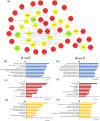Min pig skeletal muscle response to cold stress
- PMID: 36155652
- PMCID: PMC9512212
- DOI: 10.1371/journal.pone.0274184
Min pig skeletal muscle response to cold stress
Abstract
The increased sensitivity of pigs to ambient temperature is due to today's intensive farming. Frequent climate disasters increase the pressure on healthy pig farming. Min pigs are an indigenous pig breed in China with desirable cold resistance characteristics, and hence are ideal for obtaining cold-resistant pig breeds. Therefore, it is important to discover the molecular mechanisms that are activated in response to cold stress in the Min pig. Here, we conducted a transcriptomic analysis of the skeletal muscle of Min pigs under chronic low-temperature acclimation (group A) and acute short cold stress (group B). Cold exposure caused more genes to be upregulated. Totals of 125 and 96 differentially expressed genes (DEGs) were generated from groups A and B. Sixteen common upregulated DEGs were screened; these were concentrated in oxidative stress (SRXN1, MAFF), immune and inflammatory responses (ITPKC, AREG, MMP25, FOSL1), the nervous system (RETREG1, GADD45A, RCAN1), lipid metabolism (LRP11, LIPG, ITGA5, AMPD2), solute transport (SLC19A2, SLC28A1, SLCO4A1), and fertility (HBEGF). There were 102 and 73 genes that were specifically differentially expressed in groups A and B, respectively. The altered mRNAs were enriched in immune, endocrine, and cancer pathways. There were 186 and 91 differentially expressed lncRNAs generated from groups A and B. Analysis of the target genes suggested that they may be involved in regulating the MAPK signaling pathway for resistance to cold. The results of this study provide a comprehensive overview of cold exposure-induced transcriptional patterns in skeletal muscle of the Min pig. These results can guide future molecular studies of cold stress response in pigs for improving cold tolerance as a goal in breeding programs.
Conflict of interest statement
The authors have declared that no competing interests exist.
Figures





Similar articles
-
Distinct Transcriptional Responses of Skeletal Muscle to Short-Term Cold Exposure in Tibetan Pigs and Bama Pigs.Int J Mol Sci. 2023 Apr 18;24(8):7431. doi: 10.3390/ijms24087431. Int J Mol Sci. 2023. PMID: 37108597 Free PMC article.
-
The Role of lncRNAs in Pig Muscle in Response to Cold Exposure.Genes (Basel). 2023 Sep 30;14(10):1901. doi: 10.3390/genes14101901. Genes (Basel). 2023. PMID: 37895249 Free PMC article.
-
Characterization of pig skeletal muscle transcriptomes in response to low temperature.Vet Med Sci. 2023 Jan;9(1):181-190. doi: 10.1002/vms3.1025. Epub 2022 Dec 8. Vet Med Sci. 2023. PMID: 36480456 Free PMC article.
-
Transcriptome Analysis Revealed Potential Genes of Skeletal Muscle Thermogenesis in Mashen Pigs and Large White Pigs under Cold Stress.Int J Mol Sci. 2023 Oct 24;24(21):15534. doi: 10.3390/ijms242115534. Int J Mol Sci. 2023. PMID: 37958518 Free PMC article.
-
Transcriptomics Analysis on Excellent Meat Quality Traits of Skeletal Muscles of the Chinese Indigenous Min Pig Compared with the Large White Breed.Int J Mol Sci. 2017 Dec 22;19(1):21. doi: 10.3390/ijms19010021. Int J Mol Sci. 2017. PMID: 29271915 Free PMC article.
Cited by
-
Systematically identifying genetic signatures including novel SNP-clusters, nonsense variants, frame-shift INDELs, and long STR expansions that potentially link to unknown phenotypes existing in dog breeds.BMC Genomics. 2023 Jun 5;24(1):302. doi: 10.1186/s12864-023-09390-6. BMC Genomics. 2023. PMID: 37277710 Free PMC article.
-
The Role of β3-Adrenergic Receptors in Cold-Induced Beige Adipocyte Production in Pigs.Cells. 2024 Apr 19;13(8):709. doi: 10.3390/cells13080709. Cells. 2024. PMID: 38667324 Free PMC article.
-
Characteristics of cell adhesion molecules expression and environmental adaptation in yak lung tissue.Sci Rep. 2025 Mar 29;15(1):10914. doi: 10.1038/s41598-025-95882-2. Sci Rep. 2025. PMID: 40158021 Free PMC article.
-
Hypothalamic Neuromodulation of Hypothermia in Domestic Animals.Animals (Basel). 2024 Feb 4;14(3):513. doi: 10.3390/ani14030513. Animals (Basel). 2024. PMID: 38338158 Free PMC article. Review.
-
Distinct Transcriptional Responses of Skeletal Muscle to Short-Term Cold Exposure in Tibetan Pigs and Bama Pigs.Int J Mol Sci. 2023 Apr 18;24(8):7431. doi: 10.3390/ijms24087431. Int J Mol Sci. 2023. PMID: 37108597 Free PMC article.
References
Publication types
MeSH terms
Substances
LinkOut - more resources
Full Text Sources
Miscellaneous

